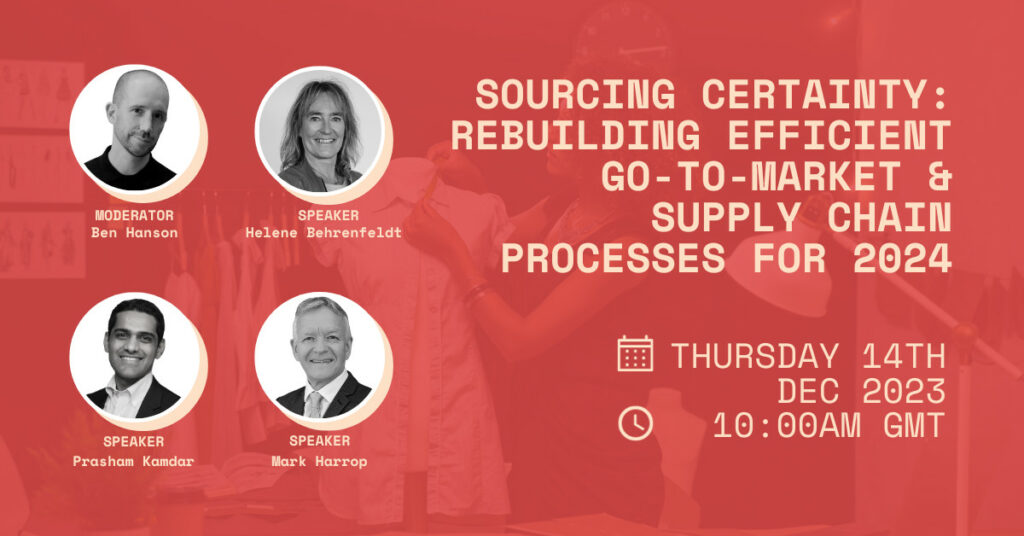Sign up to Interline Insiders to receive our weekly analysis in your inbox every Friday.

As we have in previous years, The Interline has selected three of the top findings from Business of Fashion / McKinsey & Company’s excellent annual “State of Fashion” report, and used them as a foundation for a deeper exploration of the role technology might play in the near future.
By now, fashion professionals have likely been part of many discussions highlighting the extraordinary global circumstances that are influencing the industry. And the unprecedented events have kept rolling in. In 2023, another war broke out, inflation and cost of living soared, AI advanced further and faster than imagined, and climate change affected almost all parts of the globe.
It’s the best of times in some areas, and the worst in others. We are, as the latest milestone report puts it, in the midst of the storm.
“With clouds brewing on the horizon, recent years might provide a sense of how the fashion industry will ride out 2024,” reads the first line of McKinsey & Company’s recently released State of Fashion 2024 report. And the sense is that even with the trepidation felt everywhere, the industry is resilient and will ride out the storm. The 128-pager that seeks to capture the zeitgeist of the fashion industry – as well as giving its predictions for the upcoming year – will likely serve as one of the fashion industry’s most referenced documents as we head into the new year.
Of the 10 themes covered, The Interline has selected three that warrant a deeper analysis from a technology perspective: (Fashion’s) Fragmented Future; Climate Urgency; and Gen(erative) AI’s Creative Crossroad. All three speak to the transition and adaptation that is underway in the fashion industry; driven by economic uncertainties, dramatic environmental changes, technological advancements, and shifting consumer preferences.

Fashion’s Fragmented Future
As the theme name suggests, the picture isn’t rosy. Globally, economic prospects for the coming year are anticipated to be shaped by decelerating growth, ongoing and emerging geopolitical tensions, and challenges in consumer spending. Global GDP growth is set to slow to 2.9% in 2024, while the fashion industry’s year-on-year growth is predicted to only be between 2% and 4%.
But even in tough times, there is still room for growth and for opportunity. It might just mean being open to new ways of working for all the stakeholders in the fashion value chain. This could look like leaning on technology to build resilience and mitigate risk in the supply chain, personalise for the consumer as far as possible, and automate wherever feasible.
Resilience is built by prioritising contingency planning: giving careful thought to situations that involve high levels of uncertainty and baking in new levels of preparation if an unexpected or worst-case scenario happens. This will need to be done for each separate region if the business operates globally.
This is where a digitally-connected and adaptable supply chain becomes essential. IoT, Blockchain, and high-tech communication platforms that support supply chain visibility and flexibility will allow fashion businesses the level of responsiveness they need to operate despite disruption. In addition, suppliers may face intensified competition in a sector susceptible to price wars due to weakened consumer demand. As orders decline, the report finds, some supply chains may experience excess capacity. To offset the impact of price competitiveness, suppliers should explore technology-enabled communication and connectivity with their brand and retail partners to strengthen collaborative ties and ensure open and frequent communication.
When it comes to the consumer, 2024 will require brands and retailers to be authentic with the consumer through social media and influencer partnerships. And given the growing preference for online shopping – particularly in the US – it will be imperative to elevate e-commerce capabilities, encompassing authenticity and connectedness.
Technology can be used here for virtual try-on, AI-powered recommendations though chatbots, and seamless omnichannel experiences. Brands and retailers can also use data analytics for comprehensive market insights, predictions on consumer behaviour, and effective inventory management. This will be crucial in navigating the uncertainty and varied conditions in different markets.
Lastly, 2024 might be the best time for fashion businesses to invest in automation technologies and other tools for streamlining and optimising manufacturing. In a slow-growth environment, improving the margin of each product sold is a key objective, and automation in the supply chain has the potential to result in a reduction in labour costs and more efficiency, precision, and speed into various stages of the production process.
In garment production, automated cutting machines can precisely cut fabric according to digital patterns, minimising material waste. Sewing robots are increasingly taking over repetitive and time-consuming tasks, accelerating the assembly of garments. On the operations side, automated systems used in logistics and distribution are improving productivity and contributing to higher quality standards and cost-effectiveness overall.
Climate Emergency
By 2030 (which is about to be just 6 years away) more than US$65 billion of apparel exports are at risk of being wiped out by climate events such as flooding and extreme heat. Also at risk are nearly one million jobs in four economies that are among the most central to the global fashion industry.

The point to drive home here is that every part of the fashion value chain is affected by the climate crisis, particularly as the industry heavily depends on countries and regions directly affected by climate disruptions – regions that are more widespread and closer to home than many organisations think. And while climate action and sustainability are now firmly on fashion’s priority list, there is still the sense that they are long-term projects to be tackled further down the line.
This is not the case. The situation is now beyond urgent, as we’re on track to exceed the 1.5˚C climate goal by the early 2030s.
Part of fashion’s problem when it comes to climate change and the sustainability agenda is that no group wants to accept the responsibility as being theirs. Who should do the heavy lifting: brands and retailers, or is it suppliers? The simple, and complex, answer is that it’s on everyone. The fight for a more sustainable fashion industry is not the sole responsibility of any one segment of the value chain, and brands must work with suppliers to evaluate the standards and invest where necessary – being sure to address new climate-related considerations.
Soon, however, there won’t be a choice. Finally moving away from self-regulation, there are now 16 pieces of legislation relating to fashion and textiles under discussion in late 2023 in the EU. The regulations cover the entire spectrum of the fashion value chain, covering everything from product design to marketing, with global implications for consumers and companies alike.
The C-Suite and other key decision-makers are taking notice. 87% of fashion executives think sustainability regulations will impact their businesses in 2024, and the picture we painted in The Interline’s Sustainability Report 2023 was of an industry where an immature solution landscape was being tasked with probably the most vital challenge in the industry’s history.
So, the heat is on for regulatory compliance, and the landscape is not an easy one to navigate. How can technology help? There are two ways. First, fashion businesses can implement technologies that improve sustainability, and supply chain transparency, or using traditional machine learning (the more stress-tested cousin of generative AI )for optimising material usage and reducing waste. Technology can also assist with achieving complete visibility across the manufacturing supply chain, a key factor in meeting regulatory compliance. Blockchain, for instance, allows for an immutable and transparent record of transactions, ensuring the traceability of products from manufacturing to delivery.
Digital platforms like some of the solutions captured in our Sustainability Report enable real-time tracking and monitoring of the supply chain, providing accurate and standardised data. Advanced analytics and AI can be used to analyse vast amounts of data, identify patterns, and assess the environmental and social impact of a given supply chain. The downside is that sometimes the data can be limited, or even based on incorrect foundations, as many brands don’t have high visibility into their supplier networks, meaning that there is a lack of standardised data for meaningful progress.
The second way that technology can assist with the regulatory changes in the fashion industry is by facilitating businesses to keep track of all the relevant rules, as well as capture the relevant data that verifies how the particular business is compliant. This type of information is becoming increasingly important to the environmentally and socially conscious consumer.
A key innovation for this customer is the digital product passport – expected to become a legal requirement – that gives the consumer access to detailed information about the product and its manufacturing, sourcing, and lifecycle. The passport typically includes details such as the product’s origin, materials used, manufacturing processes, and environmental impact. Blockchain technology is often employed to ensure the integrity and security of this digital record.
Generative AI: Just the Beginning
AI: the fashion industry’s new frenemy. Something to be intrigued by, to use and be amazed, as well as to fear. McKinsey reports that 73% of fashion executives see generative AI as a priority for their companies in 2024, but only 5% believe they have the capabilities to fully leverage it. This, to us, feels quite representative of the world as a whole, as we pass ChatGPT’s first birthday.

Generative AI, specifically, refers to technology that creates new content, like images or text, by learning patterns from existing data. The generative models generally in the news these days – large language models (LLMs) are based on Transformers, a type of model introduced by Google researchers in 2017. LLMs in a text-context are largely trained to do next word prediction. So, given some input (a prompt), it looks for the most likely following words based on its training data. This technology finds applications in creating images, texts, and more, making it a valuable tool for various creative tasks.
As per the report, as much as one-fourth of generative AI’s potential value in fashion may be driven by use cases in design and product development – although our instant feeling is that the accuracy / hallucination threshold has likely not been reached yet when it comes to the level of precision and reliability needed for technical design or product development.
Online shopping assistance is another area where AI is making its mark. Online retailer Zalando announced the launch of a beta ChatGPT-based natural language-powered shopping assistant in spring 2023 that allows a visitor to its site to ask questions and get answers as well as customised product recommendations. Kering, Mercari and Shopify have similarly introduced AI chatbots.
Generative AI is also being used further down the value chain, in organisation and support functions to create individualised training materials based on roles; in sales and customer experience by drafting product descriptions for e-commerce sites, and in supply chain and logistics to offer real-time demand forecasting by combining insights from multiple datasets.
But ultimately, generative AI’s real value in fashion is seen when it’s used from start to finish, boosting creativity rather than replacing it. In fashion, where human creativity is crucial, this technology can free up designers from manual tasks, letting them focus on creative work. Instead of replacing designers, generative AI shifts their roles towards curation. Communicating this clearly to creatives is essential for adopting the technology, emphasising their role is not diminished.
Whether brands, retailers, and suppliers choose to take cover and be more cautious or brave the weather, 2024 is set to be tempestuous with supply/ demand challenges, more advances in AI, and new sustainability regulations.
Upcoming Webinar – Sourcing Certainty For 2024:

In two weeks’ time, The Interline will be hosting a live online event, featuring speakers from Infor, Ptex Solutions, and WhichPLM Advisory, where we’ll be working to debrief the audience on the key challenges the fashion industry has faced in 2023, and to look forward at strategies and solutions for re-establishing certainty and efficiency across the value chain in 2024. The 45-minute event is free to attend, and you can register from today.
The best from The Interline:

Garrett Gerson of Variant3D kicked off this week, calling for an immediate change in our industry’s unsustainable business model. To make a meaningful dent in the industry’s outsize footprint, and to realign supply with demand, he explains, fashion will need to build fully digital value chains – from design to on-demand production.

Released in The Interline’s first Sustainability Report, Paul Magel of CGS talks about how, when it comes to sustainability, everything – reputation, trust, sales, profits – is interconnected.

Tricia Carey of Renewcell closes our week with her view on how fashion has reached the stage where sustainability commitments must urgently translate into change in the core industrial processes that bring products to market.

